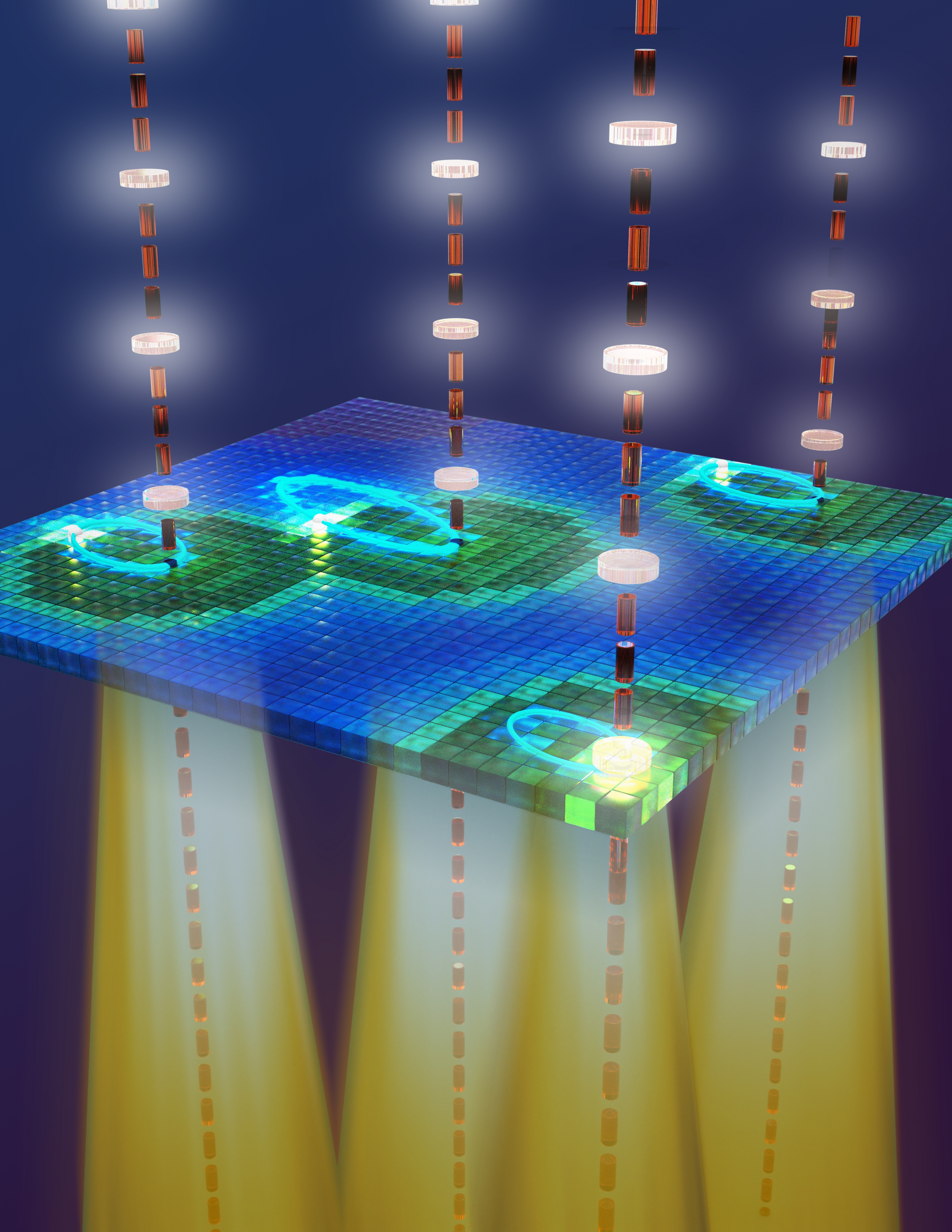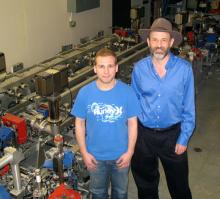

A team of physicists at UC Santa Barbara has seen the light, and it comes in many different colors. By aiming high- and low-frequency laser beams at a semiconductor, the researchers caused electrons to be ripped from their cores, accelerated, and then smashed back into the cores they left behind. This recollision produced multiple frequencies of light simultaneously. Their findings appear in the current issue of the science journal Nature.
"This is a very remarkable phenomenon. I have never seen anything like this before," said Mark Sherwin, whose research group made the groundbreaking discovery. Sherwin is a professor of physics at UCSB and a co-author of the paper. He is also director of the campus's Institute for Terahertz Science and Technology.
When the high-frequency optical laser beam hits the semiconductor material –– in this case, gallium arsenide nanostructures –– it creates an electron-hole pair called an exciton. The electron is negatively charged, and the hole is positively charged, and the two are bound together by their mutual attraction. "The high-frequency laser creates electrons and holes," Sherwin explained. "The very strong, low-frequency free electron laser beam rips the electron away from the hole and accelerates it. As the low-frequency field oscillates, it causes the electron to come careening back to the hole." The electron has excess energy because it has been accelerated, and when it slams back into the hole, the recombined electron-hole pair emits photons at new frequencies.
"It's fairly routine to mix the lasers and get one or two new frequencies, Sherwin continued. "But to see all these different new frequencies, up to 11 in our experiment, is the exciting phenomenon. Each frequency corresponds to a different color."
In terms of real-world applications, the electron-hole recollision phenomenon has the potential to significantly increase the speed of data transfer and communication processes. One possible application involves multiplexing –– the ability to send data down multiple channels –– and another is high-speed modulation.
"Think of your cable Internet," explained Ben Zaks, a UCSB doctoral student in physics and the paper's lead author. "The cable is a bundle of fiber optics, and you're sending a beam with a wavelength that's approximately 1.5 microns down the line. But within that beam there are a lot of frequencies separated by small gaps, like a fine-toothed comb. Information going one way moves on one frequency, and information going another way uses another frequency. You want to have a lot of frequencies available, but not too far from one another."
The electron-hole recollision phenomenon does just that –– it creates light at new frequencies, with optimal separation between them.
The researchers utilize a free electron laser –– a building-size machine in UCSB's Broida Hall –– to produce the electron-hole recollisions, which they note is not practical for real-world applications. Theoretically, however, a transistor could be used in place of the free electron laser to produce the strong terahertz fields. "The transistor would then modulate the near infrared beam," Zaks continued. "Our data indicates that we are modulating the near infrared laser at twice the terahertz frequency. This is where we could really see this working to increase the speed of optical modulation, which is how you get information down a cable line."
The electron-hole recollision phenomenon creates many new avenues for research and exploration, Sherwin noted. "It is an interesting time because there are a lot of people who can participate in doing this kind of research," he said. "We have a unique tool –– a free electron laser –– which gives us a big advantage for exploring the properties of fundamental materials. We just put it in front of our laser beams and measure the colors of light going out. Now that we've seen this phenomenon, we can start doing the hard work of putting the pieces together on a chip."
In discussing the research team's discovery, Sherwin cited Michael Polanyi, the Hungarian scientist and science philosopher. "He talked about growing points in science, and I'm hoping this is going to be one of those, where a lot of people can use it as a foundation for going off in a lot of different directions," he said. "I want to continue working on it, but I'd like to see a lot of other people join in."
Also contributing to the research is the paper's second author, R.B. Liu of The Chinese University in Hong Kong. "This is an excellent example of the value of communicating with scientists from all over the globe," said Sherwin. "If we had never met, this research would not have happened."
† Bottom image: Artist's rendition of electron-hole recollision. Near infrared (amber rods) and terahertz (yellow cones) radiation interact with a semiconductor quantum well (tiles).
The near-ir radiation creates excitons (green tiles) consisting of a negative electron and a positive hole (dark blue tile at center of green tiles) bound in an atom-like state. Intense terahertz fields pull the electrons (white tiles) first away from the hole and then back towards it (electron paths represented by blue ellipses). Electrons periodically recollide with holes, creating periodic flashes of light (white disks between amber rods) that are emitted and detected as sidebands.
Credit: Peter Allen, UCSB
Related Links



